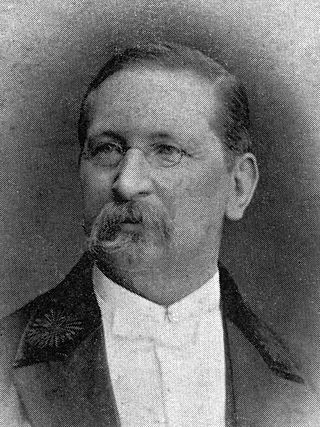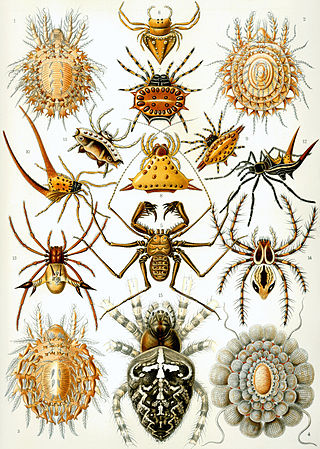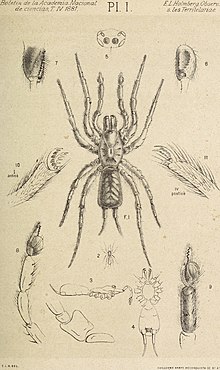
Erckmann-Chatrian was the name used by French authors Émile Erckmann (1822–1899) and Alexandre Chatrian (1826–1890), nearly all of whose works were jointly written.

Tord Tamerlan Teodor Thorell was a Swedish arachnologist.

Dwarf tarantulas, also known as sheet funnel-web spiders are a type of spider from the family Mecicobothriidae. Dwarf tarantulas are one of several families of the suborder Mygalomorphae; this larger group also includes the true tarantulas.

Nemesiidae, also known as funnel-web trapdoor spiders, is a family of mygalomorph spiders first described by Eugène Simon in 1889, and raised to family status in 1985. Before becoming its own family, it was considered part of "Dipluridae".

Eduardo Ladislao Holmberg was an Argentine natural historian and novelist, one of the leading figures in Argentine biology. Together with Florentino Ameghino he undertook the inventory of Argentine flora and fauna, and explored all the ecoregions in the country, summarizing for the first time the biodiversity of its territory. The son of botanical aficionado Eduardo Wenceslao Holmberg and grandson of the Baron Holmberg, Holmburg accompanied Argentine Libertador Manuel Belgrano on his campaigns and introduced the cultivation of the camellia to Argentina. As director of the Buenos Aires Zoological Garden he greatly developed its scientific aspect, publishing booklets and providing printed media for a learned appreciation of its contents. He also directed the Natural History Cabinet of the University of Buenos Aires and published the standard reference works on botany and zoology used in his country for most of the 20th century.

Trichonephila edulis is a species of large spider of the family Araneidae, formerly placed in the genus Nephila. It is referred to by the common name Australian golden orb weaver. It is found in Indonesia from Java eastwards, Papua New Guinea, Australia, northern New Zealand, and New Caledonia.
Rhode is a genus of woodlouse hunting spiders that was first described by Eugène Simon in 1882.

Telema is a genus of long-legged cave spiders that was first described by Eugène Louis Simon in 1882.

Mastophora, also known as bolas spiders, is a genus of orb-weaver spiders first described by E. L. Holmberg in 1876. They can be identified by a pair of lumps on the dorsal surface of the opisthosoma, though not all males will have these lumps.
Stenoterommata is a genus of South American araneomorph spiders in the family Pycnothelidae. It was first described by E. L. Holmberg in 1881. Originally placed with the Ctenizidae, it was transferred to the funnel-web trapdoor spiders in 1985, then to the Pycnothelidae in 2020. It is a senior synonym of Ctenochelus.

Axyracrus is a genus of South American anyphaenid sac spiders containing the single species, Axyracrus elegans. It was first described by Eugène Simon in 1884, and has only been found in Chile and Argentina. It is a senior synonym of "Schiapellia"

Gnolus is a genus of South American orb-weaver spiders that was first described by Eugène Louis Simon in 1879. Originally placed with the orb-weaving spiders, it was transferred to the pirate spiders in 1993, but moved back to orb-weaver family in 2012.
Synotaxus is a genus of araneomorph spiders in the family Synotaxidae that was first described by Eugène Louis Simon in 1895. Originally placed with the tangle web spiders, it was moved to the monotypic family Synotaxidae in 2017.

Actinosoma is a genus of orb-weaver spiders containing the single species, Actinosoma pentacanthum. It was first described by E. L. Holmberg in 1883, and is found throughout South America, from Colombia to Argentina.
Corynethrix is a monotypic genus of South Pacific crab spiders containing the single species, Corynethrix obscura. It was first described by Ludwig Carl Christian Koch in 1876 based on a female specimen. They have been found in New South Wales and Queensland. A male has not yet been identified, and there is very little known about the biology and behaviour of this species and its relatives.

Chilobrachys dyscolus is a species of spider in the tarantula family (Theraphosidae) native to Vietnam. It was first described by Eugène Simon in 1886 as Phrictus dyscolus. It is known as the blue Vietnam tarantula, Asian blue smokey tarantula, Asian smokey earth tiger tarantula or Burma chocolate brown tarantula.
Pycnothelidae is a family of mygalomorph spiders first described in 1917. It was downgraded to a subfamily of the funnel-web trapdoor spiders in 1985, but returned to family status in 2020.

Mecicobothrium thorelli is a spider in the family Mecicobothriidae, native to Argentina and Uruguay. It was first described in 1882 by Holmberg. The specific name thorelli honours Tamerlan Thorell. The species is most abundant in autumn and winter.

Cyrtarachninae is a subfamily of spiders in the family Araneidae. The group has been circumscribed in several different ways. It originated as the group Cyrtarachneae, described by Eugène Simon in 1892. The group was later treated at different ranks: as a tribe, both under Simon's name and as Cyrtarachnini, and as the subfamily Cyrtarachninae. Circumscriptions have varied. The broadest circumscription, Cyrtarachninae sensu lato (s.l.), includes three of Simon's original groups, including the bolas spiders. Unlike most araneids, members of the subfamily do not construct orb webs, some not using webs at all to capture prey, some using one or more sticky drops on a single line, while others construct webs with few widely spaced non-spiral threads, some triangular. Many have been shown to attract prey by producing analogues of insect sex pheromones, particularly to attract male moths. Adult females may mimic snails, bird droppings and other objects, and so are able to remain exposed during the day time, capturing prey at night.
Mastophora extraordinaria is a species of spider in the orb-weaver spider family Araneidae. It is found in South America. Like some other species of the genus Mastophora, adult females resemble bird droppings. Mastophora species, including M. extraordinaria, are "bolas spiders" – adult females capture their prey by using a sticky drop on the end of a single line which they swing at the target, usually a male moth attracted by the release of an analogue of the attractant sex pheromone produced by the female moth. Juveniles and adult males do not use a bolas, catching prey with their legs alone.













